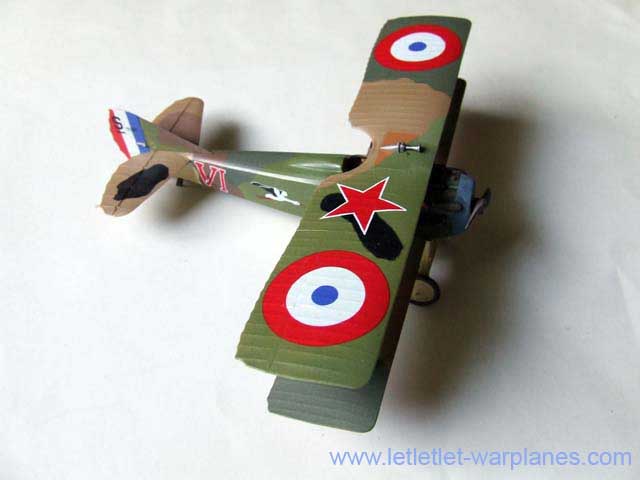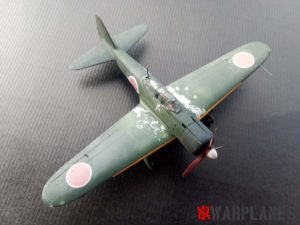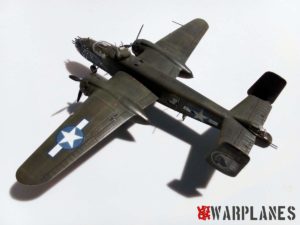S.P.A.D. XIII Eduard 1/48 8196
The French Société Pour L’Aviation et ses Dérivés (SPAD) S. XIII evolved as a development of the successful S. VII. SPAD’s Chief designer, Louis Béchereau, slightly enlarged and strengthened the S. VII airframe.
One of the main drawbacks of the S. VII was its inadequate single gun armament. The S.XIII used more powerful Hispano-Suiza engines (the 200hp HS-8Ba engine and the later HS-8Bb rated at 235hp), allowing the S. XIII to carry two Vickers machine guns with 400 rounds each.
The first prototype took to the air on April 4th, 1917 with Rene Dorme at the controls. Due to the weight increase, it was less maneuverable than the S. VII, but the rate of climb and top speed were improved. Initially, the type had rounded wing tips that were later “squared-off”. The S.XIII proved very effective in combat, .Many aces flew in it, and it was operated by many different Air Forces, including Argentina (two aircraft), Belgium, Brazil, Czechoslovakia (Post-war), France, Greece, Italy, Japan, Poland (Post-war), Russian Empire, Siam (Thailand), Kingdom of Spain, Turkey, United Kingdom, United States and Uruguay.

Eduard released a brand new kit of this plane in 1/48 scale (product number 8196) in September 2008. The kit resembles their smaller kit in 1/72 scale, and of course captures all of the quality respected for their products. The quality of the parts is first class, and the kit includes a great number of parts. Note that this is relatively small airplane. This is a special edition, including painting masks, a pre-painted etched set. The basic plastic parts are provided on three plastic frets and one clear sprue.
Regardless of the number of parts, the kit assembly is suitable for a modeler with some experience, due to the complexity. Thanks to a very good parts design, it is possible to make whole kit without use of the etched parts, so a “weekend edition” kit will likely make an appearance in the near future.
Most of the small parts are related to the cockpit. The instrument panel as well as the pilot’s seat represent the state of the art in modeling (and are easily visible when the kit is finally assembled). This kit could be built to be very authentic and eye-catching.
Four different variants may be modeled from options of
• Windscreens;
• wing centre-section;
• gun sight; and
• markings.
My choice was focused on the S.P.A.D. XIII flown in combat by the greatest French air ace, René Fonck. He was a marvelous pilot, and a skilled hunter who waited for the right moment to deliver a deadly burst from machine guns. One of his abilities was self-control and an unwavering nerve. He was attracted by chivalry and his fighting style was unlike that portrayed in novels with a ton of bullets fired, planes soaked in blood an so on… actually René Fonck reputedly shot and killed swiftly with a maximum ten bullets. His confirmed total score was 75 aerial kills including six in a single day (on 9 May 1917), and three in the space of ten seconds on 14 August of the same year. In today’s terms, he was the ultimate professional!!
There is some doubt related to the colors used and recommended in the kit. First of all, there is the blue colour of the roundel and flag. Some preserved samples indicate that this color is medium dark blue grey, but a few samples preserved in the USA indicate a deep bright blue color. The kit decals are deep bright blue, and it is more possible that the actual color blue grey. Other things which need attention are the camouflage colors.
In the French system of camouflage, the basic color was approximately 40% filled with metal pigment, and this mixture was used over the fabric-covered areas and over the metal and wood surfaces surfaces was used paint without this metal pigment, though it appeared differently over the fabric-covered surfaces compared to the metal/wood surfaces (so it should be treated as being two different colours). Please note this when making the model. In this article are attached digital chips for these colors based on published research as well as preserved samples of color. These should be considered only as a guide, as it is impossible after many decades to state correct colors. We can only note that “brown” was red brown, “ochre” could be described as light brown, “dark green” is very dark green and “light green” is a lighter version of the “dark green” (medium green). Note also that the cream color over the metal surfaces is not the same as the dope of the fabric underside.
Without doubt, this is another great product released by Eduard and it is highly recommended!!
Srecko Bradic
Text editor: Bruce Grayson
Sample kit is provided by Jana Sulcova from Eduard
















Hi!
Beautiful make Srecko, congrats. I have just ordered the kit and I started to research it.
This will be my first WWI I have many questions
How to drybrush the cocpit? Light wood?
What color of weathering wash to use? I will make Nungesser plane
Is the camo sharp-edged or little blending?
Best regards,
Tom
Greetings Tom,
first at all to thank you for your kind comment and your choice to buy this amazing kit. I use light wood base for the cockpit interior and then dry brush the surface. I recomend you to use lether color for dry brush as well this will give best effect. Camouflage pattern you see above have first time seen in the autumn 1917. Airplane was hand brushed and edges was very sharp. So if you are going to airbrush this kit, or any other with this scheme, use masking tape to determine the color shape. Hope this help.
Cheers
Thank you very much !! I go ahead then
I ordered Bob’s buckles as the rigging looks complicated
Best regards,
Tom
Good luck with your project Tom By the way- you have nice review of Bob’s buckles product on this site. Must say this is one of the best products in the field.
By the way- you have nice review of Bob’s buckles product on this site. Must say this is one of the best products in the field.
Cheers
Hello guys
I m a french pilot and a friend and I , we are building a N27 full size !
I would like to know where i can have some precises drawings of N27 camouflage colours ! we don t want to make it with nungesser color white with black heart and death skull on (too many have already been done this way)
Any help would be welcome
Greetings Jerôme!
The fellow that knows the most about French multi – colour camouflage above all would be Alan Toelle of Bellevue Washington (State) USA. He has helped dozens of museums and private collectors / builders get these colours correct. Its not for free and what ever you work out with him has nothing to do with me. (I don’t profit) he is just a very good friend who has helped me out many times. A real gentleman. You can send him a message at theaerodrome.com.
http://www.theaerodrome.com/forum/members/oldpaint.html
Thanks a lot for this contact !
I ll try to take pictures and send them once it will be done !
Hi,
in one old issue of the Over the Front magazine was published article about this pilot with a lot of images of his airplanes. I will try to get this issue and email you info about the particular plane. But as Stephen said, best info is on the link he give. TheAerodrome is the ultimate WW1 place.
Jerome! I have a Christmas present for you! Alan Toelle has asked me to contact you and offer his e-mail. Please send me an e-mail at stephen@wwinplastic.com and I will send you his e-mail address in return.
Joyeux Noel!